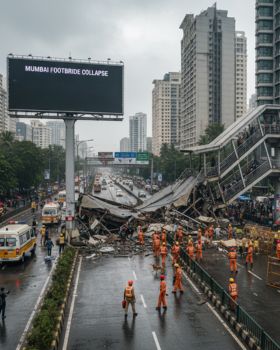
Disclaimer:
This blog post is intended for informational and educational purposes only. The content provided herein is based on publicly available information and general interpretations of the Morandi Bridge collapse. It is not intended to assign blame or liability to any specific individual, organization, or government body. All analyses, opinions, and examples presented are for awareness and discussion purposes and do not constitute professional engineering, legal, or safety advice. Readers are encouraged to consult qualified professionals and official sources when making decisions related to infrastructure safety, contractor management, or compliance. SHEQ Network disclaims any responsibility for actions taken based on the information contained in this post.
On August 14, 2018, the city of Genoa, Italy, witnessed a catastrophic event that would reshape conversations around public safety and infrastructure management for years to come. The Morandi Bridge, a key artery of the A10 motorway and a vital link for commuters and freight transport, unexpectedly collapsed during a rainstorm. This devastating incident claimed the lives of 43 individuals and left countless others grappling with its impact—physically, emotionally, and economically.
More than just a structural failure, the Genoa Bridge Collapse became a stark example of how aging infrastructure, inconsistent maintenance records, and evolving urban demands can converge into tragedy. The Morandi Bridge disaster serves today as a powerful bridge collapse case study—referenced by engineers, safety professionals, and governments worldwide to better understand and mitigate the risks associated with critical infrastructure.
Understanding What Went Wrong
Built in the 1960s, the Morandi Bridge was a cable-stayed structure with a unique design, once hailed as an engineering achievement. However, over the decades, concerns began to mount regarding the long-term durability of its concrete stays and steel reinforcements. Reports later revealed that corrosion and stress had taken a toll on the bridge’s internal components.
Despite ongoing maintenance efforts, including retrofitting and inspections, the bridge collapsed without warning. Investigations indicated that parts of the structure had weakened substantially, with insufficient intervention to prevent eventual failure.
The tragedy did not occur in isolation. It revealed systemic issues in infrastructure oversight—not just in Italy, but globally. Lack of detailed maintenance records, underfunded infrastructure programs, and pressure to maintain traffic flow without disruption often meant that critical repairs were deferred or deprioritized.
What the Morandi Bridge Disaster Teaches Us
The Morandi Bridge disaster wasn’t merely about concrete and cables—it exposed vulnerabilities in how modern societies manage and maintain vital structures. One of the key takeaways from this event is the importance of holistic infrastructure management, which includes:
- Clear contractor responsibilities
- Digital record-keeping for inspections and permits
- Accountability in maintenance timelines
- Proactive safety induction and training for involved personnel
While it is impossible to predict every potential failure, tools and systems that enhance visibility and coordination could help reduce the risk of such events. Implementing structured documentation, real-time access to safety data, and digital training portals could have helped to address some of the gaps noted in this tragedy.
It is also important to note that in 2018, many modern tools—like integrated online induction software or centralized compliance portals—were not yet standard across most global industries. The event marked a turning point for many organizations, prompting a re-evaluation of how digital tools might support safety initiatives moving forward.
Bridging the Safety Gap with Awareness and Training
The Genoa incident highlighted that safety is not just about structural engineering—it’s equally about how people are trained, how tasks are coordinated, and how well procedures are followed.
Contractors, subcontractors, and maintenance teams play crucial roles in keeping infrastructure safe. Therefore, onboarding processes and site-specific inductions need to be accurate, repeatable, and accessible. Having all stakeholders aligned on safety expectations—through clear communication and verified documentation—could help strengthen response preparedness and early detection of risks.
A digital online induction portal can support such coordination by standardizing safety messaging and ensuring contractors are properly briefed before working on high-risk or aging infrastructure. While no software alone can prevent structural failure, the ability to consistently deliver information and track compliance digitally could help improve the outcomes of both planning and response processes.
The Broader Industry Response
In the aftermath of the Genoa collapse, Italy launched a full-scale investigation and began reviewing similar structures across the country. The European Union also issued renewed guidance for infrastructure risk assessment, and engineering associations globally began re-evaluating design codes for aging bridges.
The Genoa case further ignited global discussions on the use of digital tools to support contractor management, structural inspections, and regulatory compliance. Public agencies started investing more heavily in digitization, transparency, and remote-access platforms to maintain consistent monitoring of infrastructure assets.
Conclusion: Building a Safer Future
The Genoa Bridge Collapse remains a solemn reminder of the human cost that can accompany infrastructure failures. While no software or process can undo past tragedies, adopting structured and consistent safety practices across all levels of project execution could help prevent similar incidents in the future.
Today, organizations are increasingly turning to digital tools—such as online induction software and centralized online induction portals—to enhance how contractor training and site-specific safety protocols are delivered and documented. These systems do not eliminate risks entirely, but they could help improve safety culture, strengthen compliance, and reduce miscommunication across large teams. Integrating such tools into modern infrastructure and construction workflows represents a step toward greater accountability, preparedness, and care for the people behind every project.
🔗 Learn more at sheqnetwork.com and transform the way you manage contractor safety today.
👉 Ready to see it in action? Book your free demo here!
Ready to transform? Contact us today at info@sheqnetwork.com or call us at +353 21 4536034 for a personalized demo!



